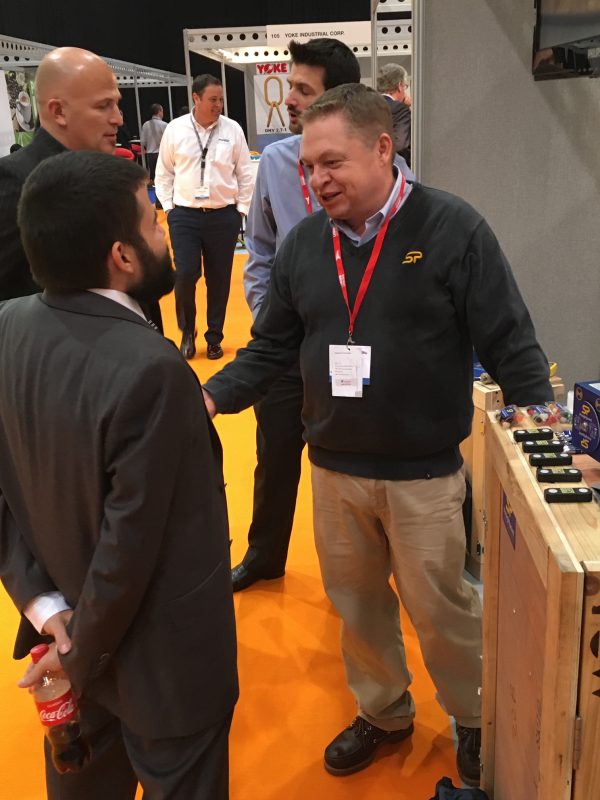
Cheers and Good luck, Thomas!
It’s a big welcome to The Crosby Group’s general manager, load monitoring, as another chapter of Straightpoint’s new ownership is opened.
Last week I sent an email to my Straightpoint (SP) colleagues, confirming that I will be stepping into another role as part of my ongoing transition away from company leadership.
Regular readers of my blog, and those I’ve worked with over the last two decades, already know the timeline:
- I bought SP on 15 April 2002.
- I sold it to The Crosby Group on 2 January 2019.
- I was named global business development director for load monitoring solutions.
- I served for six months before taking an overdue sabbatical.
- Unfinished business was on the agenda when I returned last autumn.
I guess all that remains to add is:
- The unfinished business is now finished.
- Thomas Dietvorst was named general manager, load monitoring in March 2020.
- I will continue to serve the business—and Thomas—in a long-term consultancy role.
It’s been a lot for people to keep up with, given that for 17 years the only evolution was associated with growth. And even in the last year or so the key elements of the business in terms of the product range and our status as global pioneers in the force measurement sector, have remained consistent. However, it would be trite not to acknowledge that we have come through a period of fast-paced, exciting change that has put the business I love on the threshold of its most exciting era yet.
This is no eulogy of my time at SP’s helm, but it’s opportune to use the continuation of my journey as a reference point for other individuals and businesses in a transitional phase, whether it be following an acquisition or not.
Finding Thomas
The biggest takeaway from a three-month recruitment process is that we should always be aware what is under our noses. We always had Thomas as the front-runner for the job, as he had been serving as strategic marketing manager, EMEA, at The Crosby Group, based in Belgium (Jason Colwell, managing director, EMEA, first tabled his name). There, he was responsible for overseeing product managers, training, marketing and development departments. However, only when we started to fit him into the role, did we start to realise just how well suited he was. Once placed in the load monitoring environment, it was clear he had SP DNA. An MBA without the DNA is useless, as many boardrooms across the land prove.
The second most important finding, therefore, was that we don’t know what’s right in front of us if we don’t compare and contrast it with what’s beyond the horizon. We had a blank canvas on which to write Thomas’s job description and we weren’t limited to Crosby’s existing payroll. However, the wider we searched and the more conversations we had, the more it became apparent that the right person for the job was part of the family already. It would have been a mistake not to look, though, and that’s the point. Even if the right candidate does appear to be the obvious choice, take time to exhaust all other options first.
That said, it’s important that a recruitment campaign isn’t left to meander. That fact that I’m staying in the business meant that Crosby leadership could easily have let the situation drift. I’ve seen it at other companies where someone has seemingly been retiring or leaving forever, but a replacement is never recruited. It’s boring for all in earshot when one hears, “This is my last trade show,” for the fifth time. All the while, existing leadership is in a transitional mindset and a business can lose its way. Crosby served as a good example in this instance of conducting a thorough but fast-paced campaign, completed in a timely fashion.
All together now: There’s Only One Mr. Loadlink!
It would have been a mistake for us to try to find Mr. Loadlink Mk. 2. There’s only one Mr. Loadlink, damn it! It’s not an arrogant stance and we don’t need to apply the guidance directly to me at all. To put it differently, it would be a fool’s errand for any business to try to find a direct replacement for any 20-year (or longer) owner.
In some positions it’s possible, but where do you find someone else whose sweat and blood is on the workshop floor? Show me another person who has seen the company go from two, to three, to four… employees. Introduce me to the man or woman who has travelled the world banging the SP drum and laid awake at night worrying about it as though it were a poorly infant. I’d like to meet them. And they’d probably make a great general manager, load monitoring. But they don’t exist.
Practically, this means a business in a similar position to where SP found itself at the turn of the year, must recruit to fill a new, not an existing, role. Moreover, a company at this junction in its timeline doesn’t need another entrepreneurial owner that’s going to nurture an embryo and see it through to adulthood. That job has been done. Now is the time for a professional with a different skillset that is going to take the company through its next growth spurt. Thomas has some great ideas that I would never have thought of. He sees things already that I, as the previous owner of two decades, could only understand from my own perspective. It’s going to be exciting to watch from the corner of the boardroom as the next chapter unfolds.
Anyone who, like me, is remaining in the c-suite as something of a spiritual leader must get the handover right. Thomas hasn’t stepped into a designate role nor do we both have a hand on the tiller. That wouldn’t work. I’m not going to lurk behind him like a bloated shadow. That doesn’t mean I’m going to sit back and blow smoke rings into his face either. I will provide counsel when asked and a viewpoint that only a previous owner of a business can have. Make no mistake, I fully expect it to be a role that brings its own challenges because there will be times when Thomas wants me to accurately recall the mistakes and successes of the past as part of due diligence on new product development and other endeavours.
Timing is everything
The time is right, principally for SP’s customers, for a product-centric specialist to take the reins. I expect our operations, sales, marketing, engineering and customer service teams to be reinvigorated by the appointment, which can only be good for distributors, end users and everyone else in the supply chain. In the timeline I shared at the outset, I don’t think I would have done anything a single second earlier or later than it happened. There has been a rhyme, rhythm and reason to everything that has happened since 15 April 2002, even if it didn’t always feel like it at that point in time.
I won’t pretend my heart isn’t breaking to take another agonising few steps back from the frontline. Recent decisions, however right they might be, have been hard to make. But the biggest mistake I could have made would be to remain at the coalface only to find my tools had gone blunt. SP means too much to me to let that happen.
*wipes tear from sooted cheek*
Over to you, Thomas.






